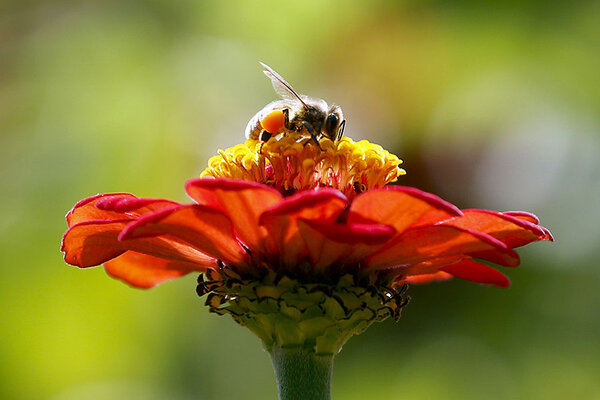
Bees are in trouble. What's being done to save them?
An annual survey of US beekeepers paints a bleak picture, with a decline of almost 50 percent in honeybee colonies. New public-private coalitions offer hope.
Honeybees are in trouble. To many people, this comes as no surprise, but the preliminary results of an annual survey have thrown the problem into sharp relief.
In their tenth annual survey, the Bee Informed Partnership found that beekeepers across the United States lost 44 percent of their honeybee colonies during the year from April 2015 to April 2016.
The pollination services of these insects are vital, directly or indirectly accounting for a staggering one third of all food we eat, and the pollinators face many varied challenges.
But the situation is not without hope, as players from all parts of society are searching for solutions to the increasingly critical threats to bees.
“We didn’t expect there to be losses in the summer,” says Dennis vanEngelsdorp, project director for the Bee Informed Partnership, in a telephone interview with The Christian Science Monitor. “We started looking at summer losses five years ago, and there wasn’t much loss. Now, they [summer and winter losses] are basically the same.”
This particular study, which captures responses from about 15 to 20 percent of US commercial and recreational beekeepers, began in response to colony collapse disorder, but that seems less of an issue today.
So, what are the current problems?
“We think it’s three major factors,” says Dr. vanEngelsdorp, who teaches entomology at the University of Maryland. “Mites, pesticides, and poor nutrition, acting in concert.”
Varroa mites are a scourge that infest beehives nationwide, and their influence is worsened by some hive management techniques. For example, a “backyard” beekeeper with 10 colonies might let nine succumb, while planning to breed that final colony as one strong enough to prevail. But in so doing, the mites are allowed to thrive and spread beyond that beekeeper’s domain.
Pesticides, by their very design, are often at odds with bees, and as for nutrition, the modern world has replaced vast swathes of meadowland with crops that starve the insects of their natural food sources.
But all is not lost. Many groups are coming together to tackle the honeybee declines.
“This is a multi-factor problem requiring a multi-factor solution,” says Julie Shapiro, senior policy director of the Keystone Policy Center, in a telephone interview with the Monitor. “All of these are key issues that need to be addressed, and we don’t try to prioritize across these areas because they are all interacting.”
The Keystone Policy Center convenes and facilitates the Honeybee Health Coalition, which brings together myriad organizations from across the spectrum – behemoths of agribusiness such as Monsanto and Syngenta, non-profits like the Foundation for the Preservation of Honey Bees, universities, and state departments of agriculture.
Together, these institutions are working on four main areas: forage and nutrition, hive management, crop pest management, and public outreach.
They seek to build understanding of one another’s viewpoints and priorities through such programs as the Bee Understanding Project, which allows people to “switch jobs for a day and walk a mile in the other guys’ boots.”
As Ms. Shapiro says, these challenges are complex, and the first step is “understanding where everyone is coming from.”
“I’m very hopeful: we’ve seen some great progress on a number of issues,” says Shapiro. “Across the board, we’ve seen tremendous engagement.”
No comments:
Post a Comment